Managing Diversity in Human Resource Management
VerifiedAdded on 2023/01/17
|12
|2943
|20
AI Summary
This assignment explores the importance of managing diversity in human resource management and provides strategies for effective people management. It discusses the impact of diversity on workplace innovation, the dimensions of diversity, the effect of diversity on workplace productivity, and the role of ethics and law in people management. The assignment also examines cross-cultural management techniques and theories of people management. Overall, it emphasizes the need for training, top management support, and appropriate remuneration to effectively manage a diverse workforce.
Contribute Materials
Your contribution can guide someone’s learning journey. Share your
documents today.

Running head: HUMAN RESOURCE MANAGEMENT
People management
Name of the student:
Name of the university:
Author note:
People management
Name of the student:
Name of the university:
Author note:
Secure Best Marks with AI Grader
Need help grading? Try our AI Grader for instant feedback on your assignments.
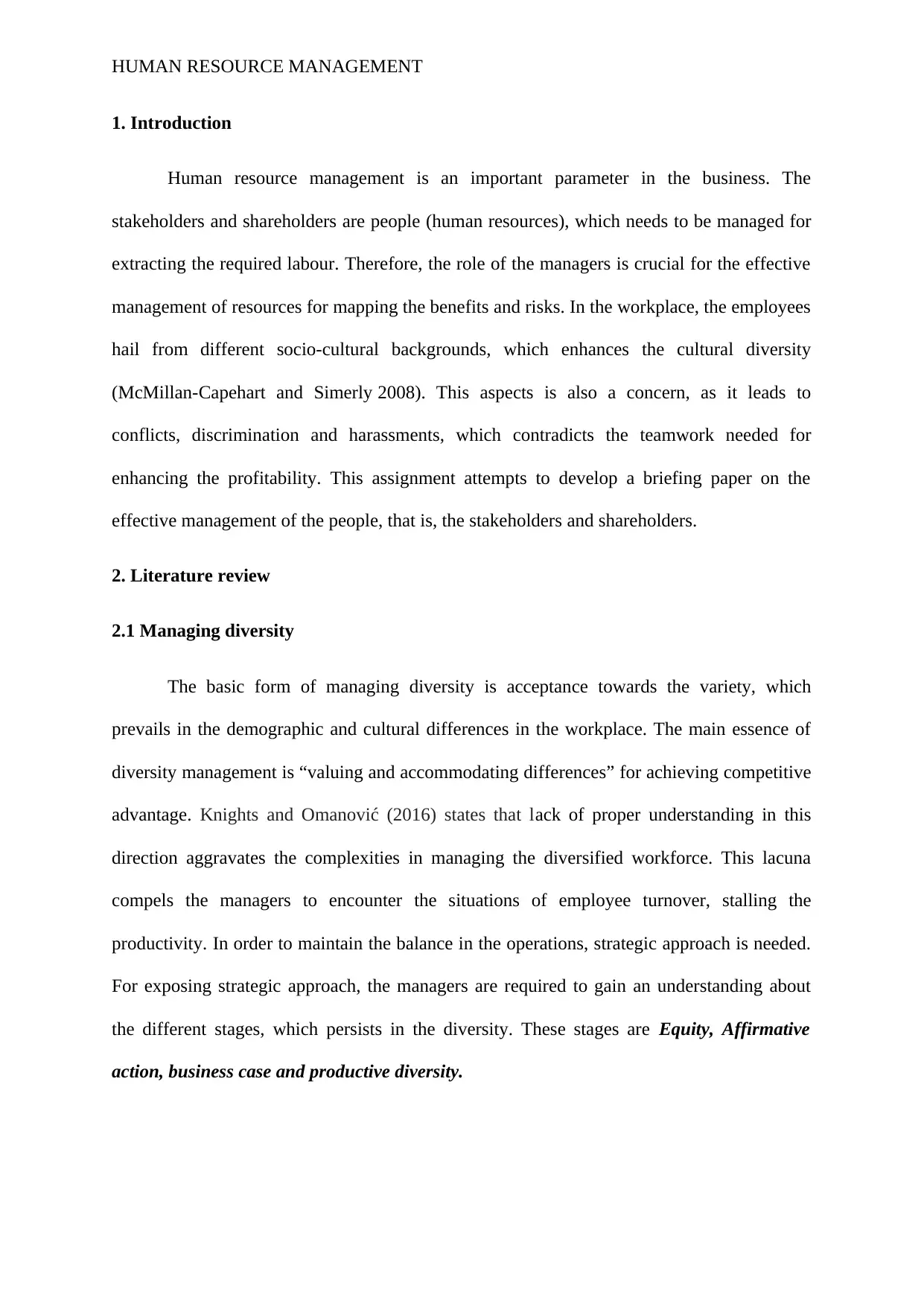
HUMAN RESOURCE MANAGEMENT
1. Introduction
Human resource management is an important parameter in the business. The
stakeholders and shareholders are people (human resources), which needs to be managed for
extracting the required labour. Therefore, the role of the managers is crucial for the effective
management of resources for mapping the benefits and risks. In the workplace, the employees
hail from different socio-cultural backgrounds, which enhances the cultural diversity
(McMillan-Capehart and Simerly 2008). This aspects is also a concern, as it leads to
conflicts, discrimination and harassments, which contradicts the teamwork needed for
enhancing the profitability. This assignment attempts to develop a briefing paper on the
effective management of the people, that is, the stakeholders and shareholders.
2. Literature review
2.1 Managing diversity
The basic form of managing diversity is acceptance towards the variety, which
prevails in the demographic and cultural differences in the workplace. The main essence of
diversity management is “valuing and accommodating differences” for achieving competitive
advantage. Knights and Omanović (2016) states that lack of proper understanding in this
direction aggravates the complexities in managing the diversified workforce. This lacuna
compels the managers to encounter the situations of employee turnover, stalling the
productivity. In order to maintain the balance in the operations, strategic approach is needed.
For exposing strategic approach, the managers are required to gain an understanding about
the different stages, which persists in the diversity. These stages are Equity, Affirmative
action, business case and productive diversity.
1. Introduction
Human resource management is an important parameter in the business. The
stakeholders and shareholders are people (human resources), which needs to be managed for
extracting the required labour. Therefore, the role of the managers is crucial for the effective
management of resources for mapping the benefits and risks. In the workplace, the employees
hail from different socio-cultural backgrounds, which enhances the cultural diversity
(McMillan-Capehart and Simerly 2008). This aspects is also a concern, as it leads to
conflicts, discrimination and harassments, which contradicts the teamwork needed for
enhancing the profitability. This assignment attempts to develop a briefing paper on the
effective management of the people, that is, the stakeholders and shareholders.
2. Literature review
2.1 Managing diversity
The basic form of managing diversity is acceptance towards the variety, which
prevails in the demographic and cultural differences in the workplace. The main essence of
diversity management is “valuing and accommodating differences” for achieving competitive
advantage. Knights and Omanović (2016) states that lack of proper understanding in this
direction aggravates the complexities in managing the diversified workforce. This lacuna
compels the managers to encounter the situations of employee turnover, stalling the
productivity. In order to maintain the balance in the operations, strategic approach is needed.
For exposing strategic approach, the managers are required to gain an understanding about
the different stages, which persists in the diversity. These stages are Equity, Affirmative
action, business case and productive diversity.
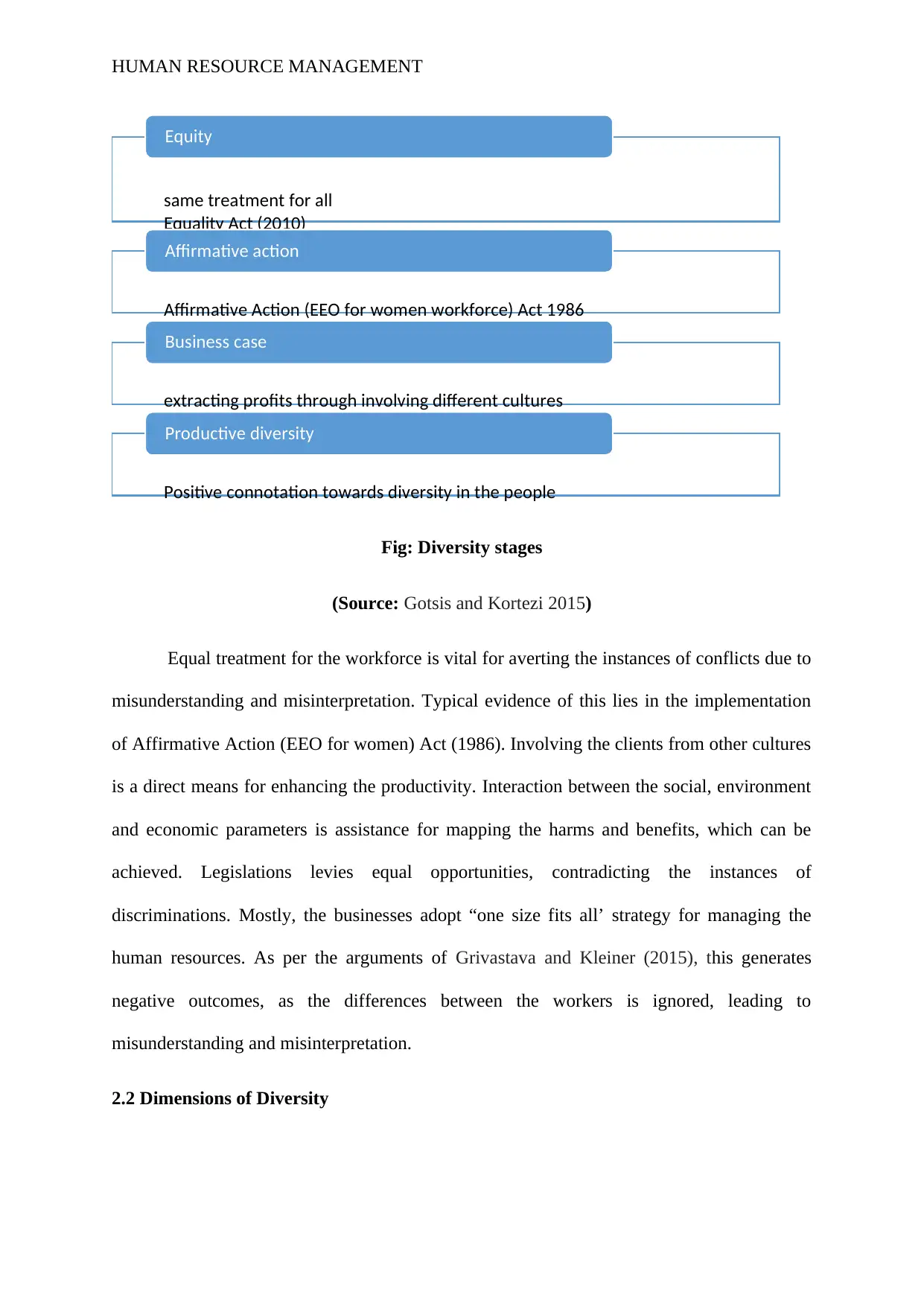
HUMAN RESOURCE MANAGEMENT
Fig: Diversity stages
(Source: Gotsis and Kortezi 2015)
Equal treatment for the workforce is vital for averting the instances of conflicts due to
misunderstanding and misinterpretation. Typical evidence of this lies in the implementation
of Affirmative Action (EEO for women) Act (1986). Involving the clients from other cultures
is a direct means for enhancing the productivity. Interaction between the social, environment
and economic parameters is assistance for mapping the harms and benefits, which can be
achieved. Legislations levies equal opportunities, contradicting the instances of
discriminations. Mostly, the businesses adopt “one size fits all’ strategy for managing the
human resources. As per the arguments of Grivastava and Kleiner (2015), this generates
negative outcomes, as the differences between the workers is ignored, leading to
misunderstanding and misinterpretation.
2.2 Dimensions of Diversity
same treatment for all
Equality Act (2010)
Equity
Affirmative Action (EEO for women workforce) Act 1986
Affirmative action
extracting profits through involving different cultures
Business case
Positive connotation towards diversity in the people
Productive diversity
Fig: Diversity stages
(Source: Gotsis and Kortezi 2015)
Equal treatment for the workforce is vital for averting the instances of conflicts due to
misunderstanding and misinterpretation. Typical evidence of this lies in the implementation
of Affirmative Action (EEO for women) Act (1986). Involving the clients from other cultures
is a direct means for enhancing the productivity. Interaction between the social, environment
and economic parameters is assistance for mapping the harms and benefits, which can be
achieved. Legislations levies equal opportunities, contradicting the instances of
discriminations. Mostly, the businesses adopt “one size fits all’ strategy for managing the
human resources. As per the arguments of Grivastava and Kleiner (2015), this generates
negative outcomes, as the differences between the workers is ignored, leading to
misunderstanding and misinterpretation.
2.2 Dimensions of Diversity
same treatment for all
Equality Act (2010)
Equity
Affirmative Action (EEO for women workforce) Act 1986
Affirmative action
extracting profits through involving different cultures
Business case
Positive connotation towards diversity in the people
Productive diversity
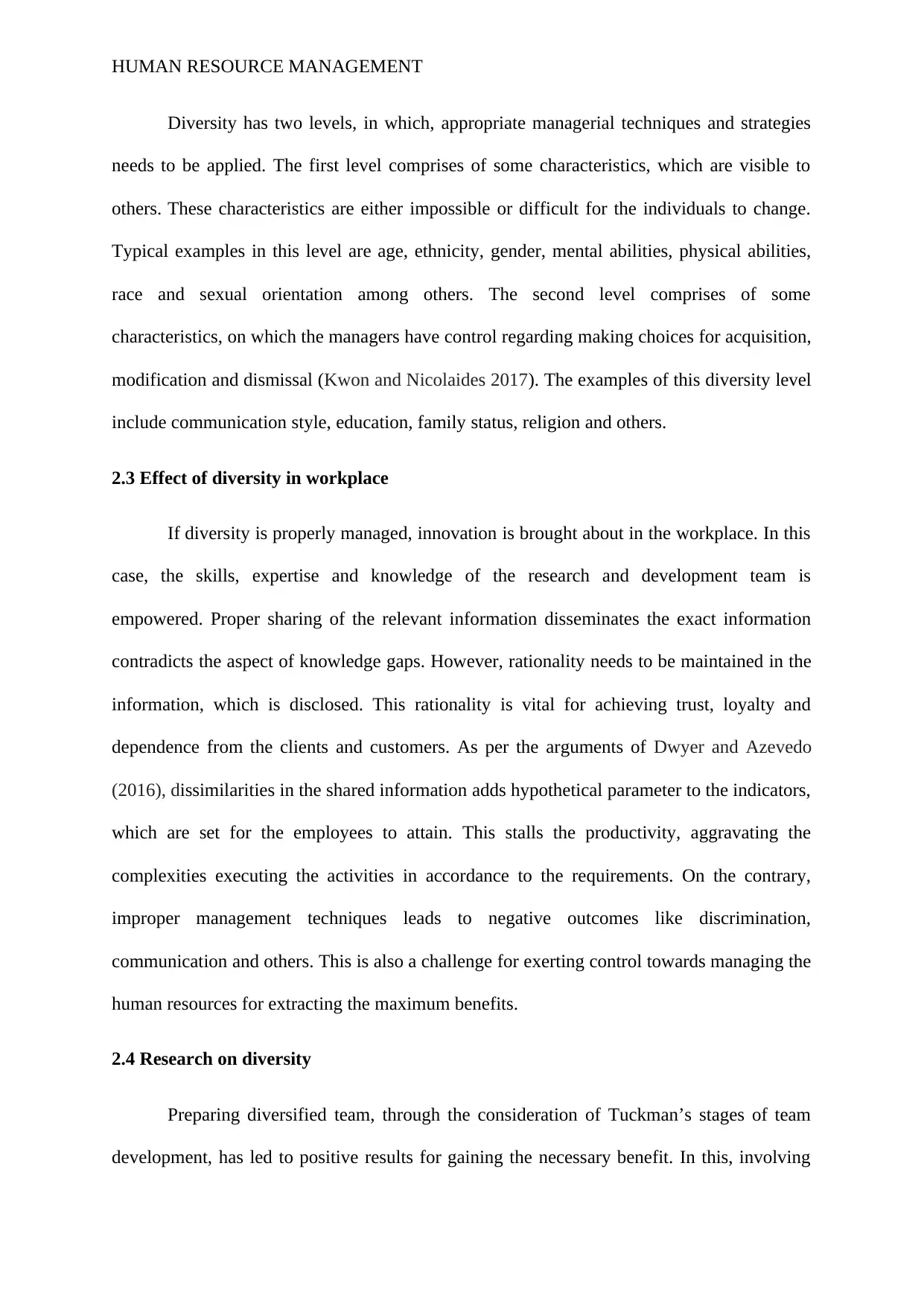
HUMAN RESOURCE MANAGEMENT
Diversity has two levels, in which, appropriate managerial techniques and strategies
needs to be applied. The first level comprises of some characteristics, which are visible to
others. These characteristics are either impossible or difficult for the individuals to change.
Typical examples in this level are age, ethnicity, gender, mental abilities, physical abilities,
race and sexual orientation among others. The second level comprises of some
characteristics, on which the managers have control regarding making choices for acquisition,
modification and dismissal (Kwon and Nicolaides 2017). The examples of this diversity level
include communication style, education, family status, religion and others.
2.3 Effect of diversity in workplace
If diversity is properly managed, innovation is brought about in the workplace. In this
case, the skills, expertise and knowledge of the research and development team is
empowered. Proper sharing of the relevant information disseminates the exact information
contradicts the aspect of knowledge gaps. However, rationality needs to be maintained in the
information, which is disclosed. This rationality is vital for achieving trust, loyalty and
dependence from the clients and customers. As per the arguments of Dwyer and Azevedo
(2016), dissimilarities in the shared information adds hypothetical parameter to the indicators,
which are set for the employees to attain. This stalls the productivity, aggravating the
complexities executing the activities in accordance to the requirements. On the contrary,
improper management techniques leads to negative outcomes like discrimination,
communication and others. This is also a challenge for exerting control towards managing the
human resources for extracting the maximum benefits.
2.4 Research on diversity
Preparing diversified team, through the consideration of Tuckman’s stages of team
development, has led to positive results for gaining the necessary benefit. In this, involving
Diversity has two levels, in which, appropriate managerial techniques and strategies
needs to be applied. The first level comprises of some characteristics, which are visible to
others. These characteristics are either impossible or difficult for the individuals to change.
Typical examples in this level are age, ethnicity, gender, mental abilities, physical abilities,
race and sexual orientation among others. The second level comprises of some
characteristics, on which the managers have control regarding making choices for acquisition,
modification and dismissal (Kwon and Nicolaides 2017). The examples of this diversity level
include communication style, education, family status, religion and others.
2.3 Effect of diversity in workplace
If diversity is properly managed, innovation is brought about in the workplace. In this
case, the skills, expertise and knowledge of the research and development team is
empowered. Proper sharing of the relevant information disseminates the exact information
contradicts the aspect of knowledge gaps. However, rationality needs to be maintained in the
information, which is disclosed. This rationality is vital for achieving trust, loyalty and
dependence from the clients and customers. As per the arguments of Dwyer and Azevedo
(2016), dissimilarities in the shared information adds hypothetical parameter to the indicators,
which are set for the employees to attain. This stalls the productivity, aggravating the
complexities executing the activities in accordance to the requirements. On the contrary,
improper management techniques leads to negative outcomes like discrimination,
communication and others. This is also a challenge for exerting control towards managing the
human resources for extracting the maximum benefits.
2.4 Research on diversity
Preparing diversified team, through the consideration of Tuckman’s stages of team
development, has led to positive results for gaining the necessary benefit. In this, involving
Secure Best Marks with AI Grader
Need help grading? Try our AI Grader for instant feedback on your assignments.
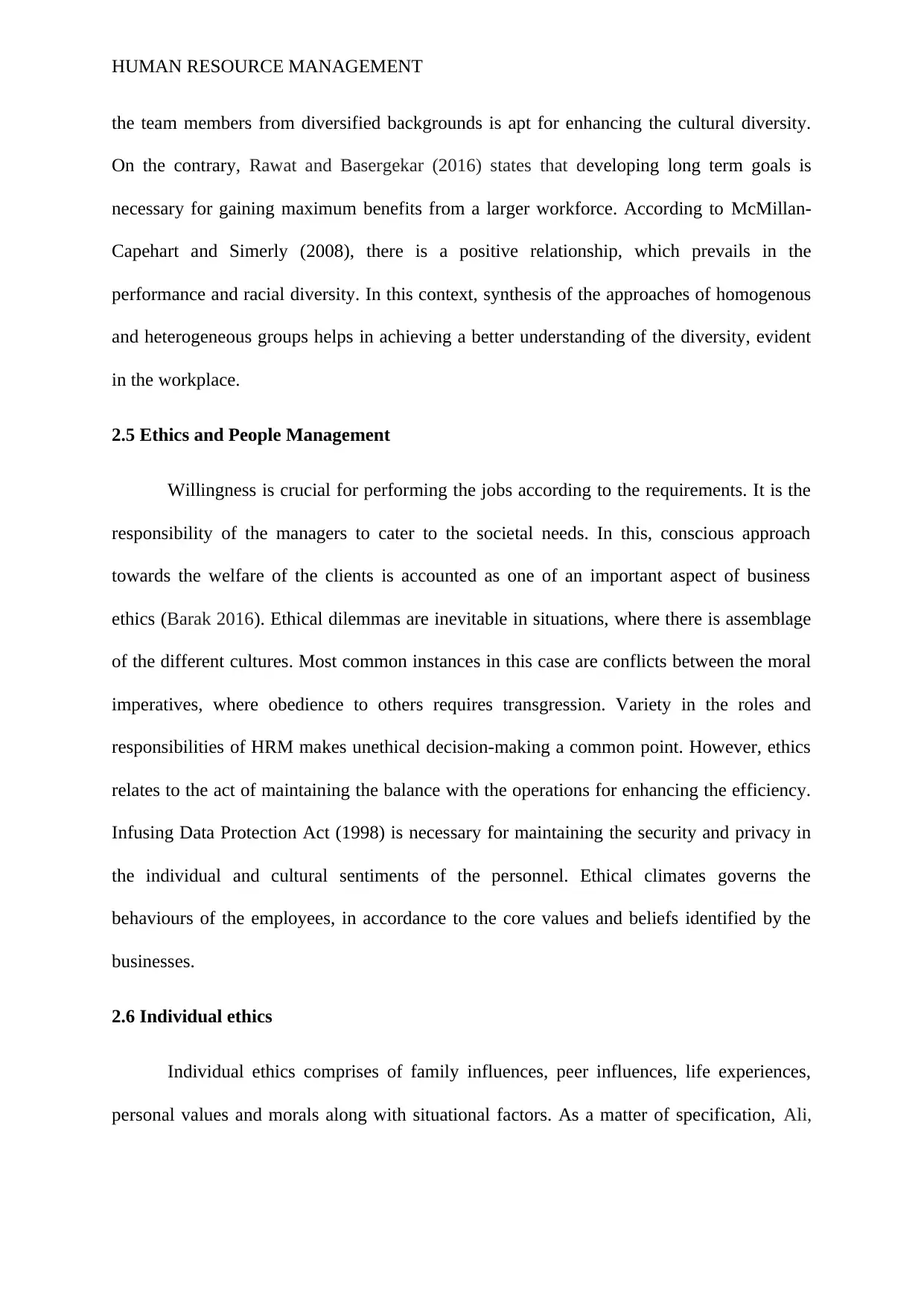
HUMAN RESOURCE MANAGEMENT
the team members from diversified backgrounds is apt for enhancing the cultural diversity.
On the contrary, Rawat and Basergekar (2016) states that developing long term goals is
necessary for gaining maximum benefits from a larger workforce. According to McMillan-
Capehart and Simerly (2008), there is a positive relationship, which prevails in the
performance and racial diversity. In this context, synthesis of the approaches of homogenous
and heterogeneous groups helps in achieving a better understanding of the diversity, evident
in the workplace.
2.5 Ethics and People Management
Willingness is crucial for performing the jobs according to the requirements. It is the
responsibility of the managers to cater to the societal needs. In this, conscious approach
towards the welfare of the clients is accounted as one of an important aspect of business
ethics (Barak 2016). Ethical dilemmas are inevitable in situations, where there is assemblage
of the different cultures. Most common instances in this case are conflicts between the moral
imperatives, where obedience to others requires transgression. Variety in the roles and
responsibilities of HRM makes unethical decision-making a common point. However, ethics
relates to the act of maintaining the balance with the operations for enhancing the efficiency.
Infusing Data Protection Act (1998) is necessary for maintaining the security and privacy in
the individual and cultural sentiments of the personnel. Ethical climates governs the
behaviours of the employees, in accordance to the core values and beliefs identified by the
businesses.
2.6 Individual ethics
Individual ethics comprises of family influences, peer influences, life experiences,
personal values and morals along with situational factors. As a matter of specification, Ali,
the team members from diversified backgrounds is apt for enhancing the cultural diversity.
On the contrary, Rawat and Basergekar (2016) states that developing long term goals is
necessary for gaining maximum benefits from a larger workforce. According to McMillan-
Capehart and Simerly (2008), there is a positive relationship, which prevails in the
performance and racial diversity. In this context, synthesis of the approaches of homogenous
and heterogeneous groups helps in achieving a better understanding of the diversity, evident
in the workplace.
2.5 Ethics and People Management
Willingness is crucial for performing the jobs according to the requirements. It is the
responsibility of the managers to cater to the societal needs. In this, conscious approach
towards the welfare of the clients is accounted as one of an important aspect of business
ethics (Barak 2016). Ethical dilemmas are inevitable in situations, where there is assemblage
of the different cultures. Most common instances in this case are conflicts between the moral
imperatives, where obedience to others requires transgression. Variety in the roles and
responsibilities of HRM makes unethical decision-making a common point. However, ethics
relates to the act of maintaining the balance with the operations for enhancing the efficiency.
Infusing Data Protection Act (1998) is necessary for maintaining the security and privacy in
the individual and cultural sentiments of the personnel. Ethical climates governs the
behaviours of the employees, in accordance to the core values and beliefs identified by the
businesses.
2.6 Individual ethics
Individual ethics comprises of family influences, peer influences, life experiences,
personal values and morals along with situational factors. As a matter of specification, Ali,
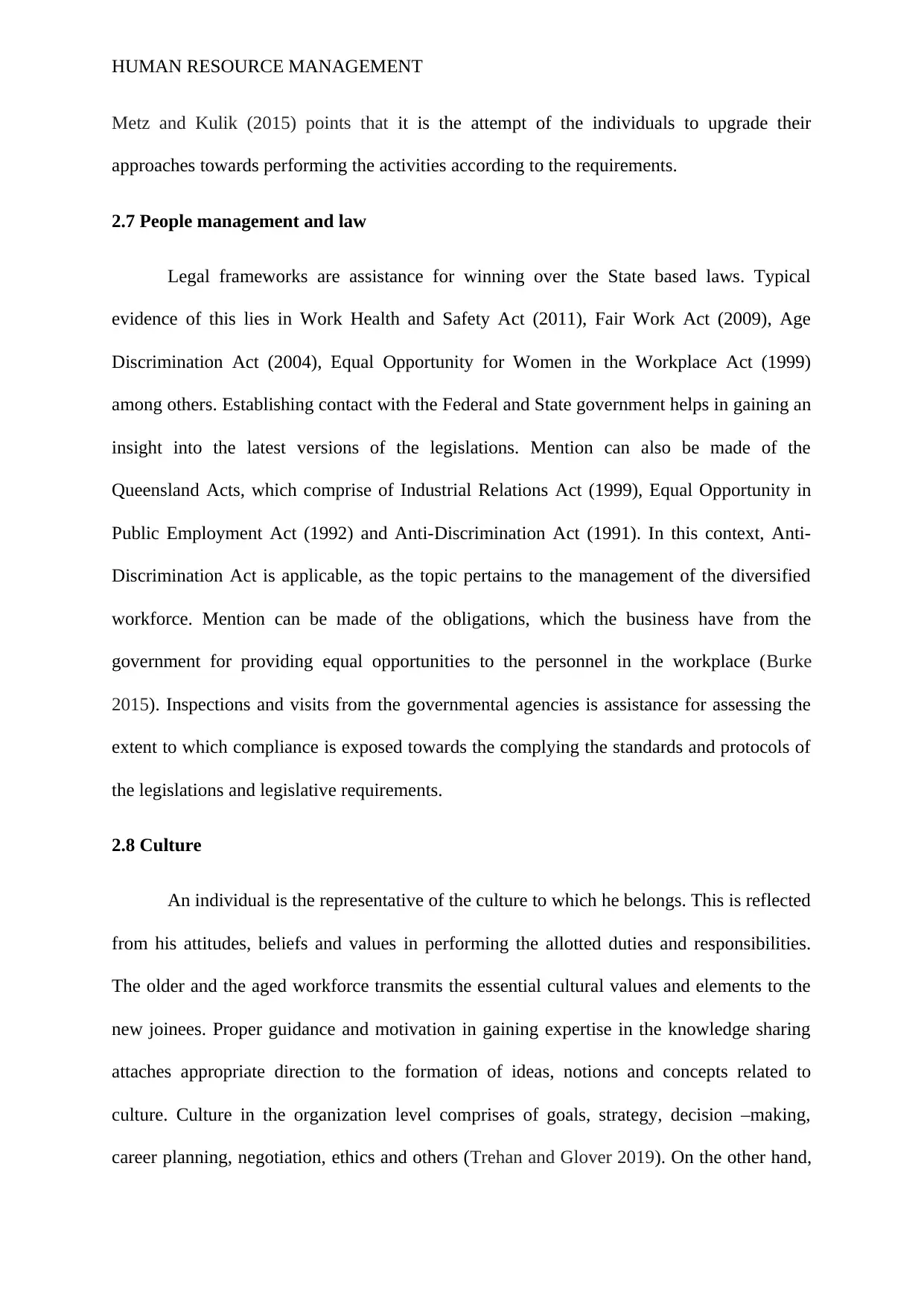
HUMAN RESOURCE MANAGEMENT
Metz and Kulik (2015) points that it is the attempt of the individuals to upgrade their
approaches towards performing the activities according to the requirements.
2.7 People management and law
Legal frameworks are assistance for winning over the State based laws. Typical
evidence of this lies in Work Health and Safety Act (2011), Fair Work Act (2009), Age
Discrimination Act (2004), Equal Opportunity for Women in the Workplace Act (1999)
among others. Establishing contact with the Federal and State government helps in gaining an
insight into the latest versions of the legislations. Mention can also be made of the
Queensland Acts, which comprise of Industrial Relations Act (1999), Equal Opportunity in
Public Employment Act (1992) and Anti-Discrimination Act (1991). In this context, Anti-
Discrimination Act is applicable, as the topic pertains to the management of the diversified
workforce. Mention can be made of the obligations, which the business have from the
government for providing equal opportunities to the personnel in the workplace (Burke
2015). Inspections and visits from the governmental agencies is assistance for assessing the
extent to which compliance is exposed towards the complying the standards and protocols of
the legislations and legislative requirements.
2.8 Culture
An individual is the representative of the culture to which he belongs. This is reflected
from his attitudes, beliefs and values in performing the allotted duties and responsibilities.
The older and the aged workforce transmits the essential cultural values and elements to the
new joinees. Proper guidance and motivation in gaining expertise in the knowledge sharing
attaches appropriate direction to the formation of ideas, notions and concepts related to
culture. Culture in the organization level comprises of goals, strategy, decision –making,
career planning, negotiation, ethics and others (Trehan and Glover 2019). On the other hand,
Metz and Kulik (2015) points that it is the attempt of the individuals to upgrade their
approaches towards performing the activities according to the requirements.
2.7 People management and law
Legal frameworks are assistance for winning over the State based laws. Typical
evidence of this lies in Work Health and Safety Act (2011), Fair Work Act (2009), Age
Discrimination Act (2004), Equal Opportunity for Women in the Workplace Act (1999)
among others. Establishing contact with the Federal and State government helps in gaining an
insight into the latest versions of the legislations. Mention can also be made of the
Queensland Acts, which comprise of Industrial Relations Act (1999), Equal Opportunity in
Public Employment Act (1992) and Anti-Discrimination Act (1991). In this context, Anti-
Discrimination Act is applicable, as the topic pertains to the management of the diversified
workforce. Mention can be made of the obligations, which the business have from the
government for providing equal opportunities to the personnel in the workplace (Burke
2015). Inspections and visits from the governmental agencies is assistance for assessing the
extent to which compliance is exposed towards the complying the standards and protocols of
the legislations and legislative requirements.
2.8 Culture
An individual is the representative of the culture to which he belongs. This is reflected
from his attitudes, beliefs and values in performing the allotted duties and responsibilities.
The older and the aged workforce transmits the essential cultural values and elements to the
new joinees. Proper guidance and motivation in gaining expertise in the knowledge sharing
attaches appropriate direction to the formation of ideas, notions and concepts related to
culture. Culture in the organization level comprises of goals, strategy, decision –making,
career planning, negotiation, ethics and others (Trehan and Glover 2019). On the other hand,
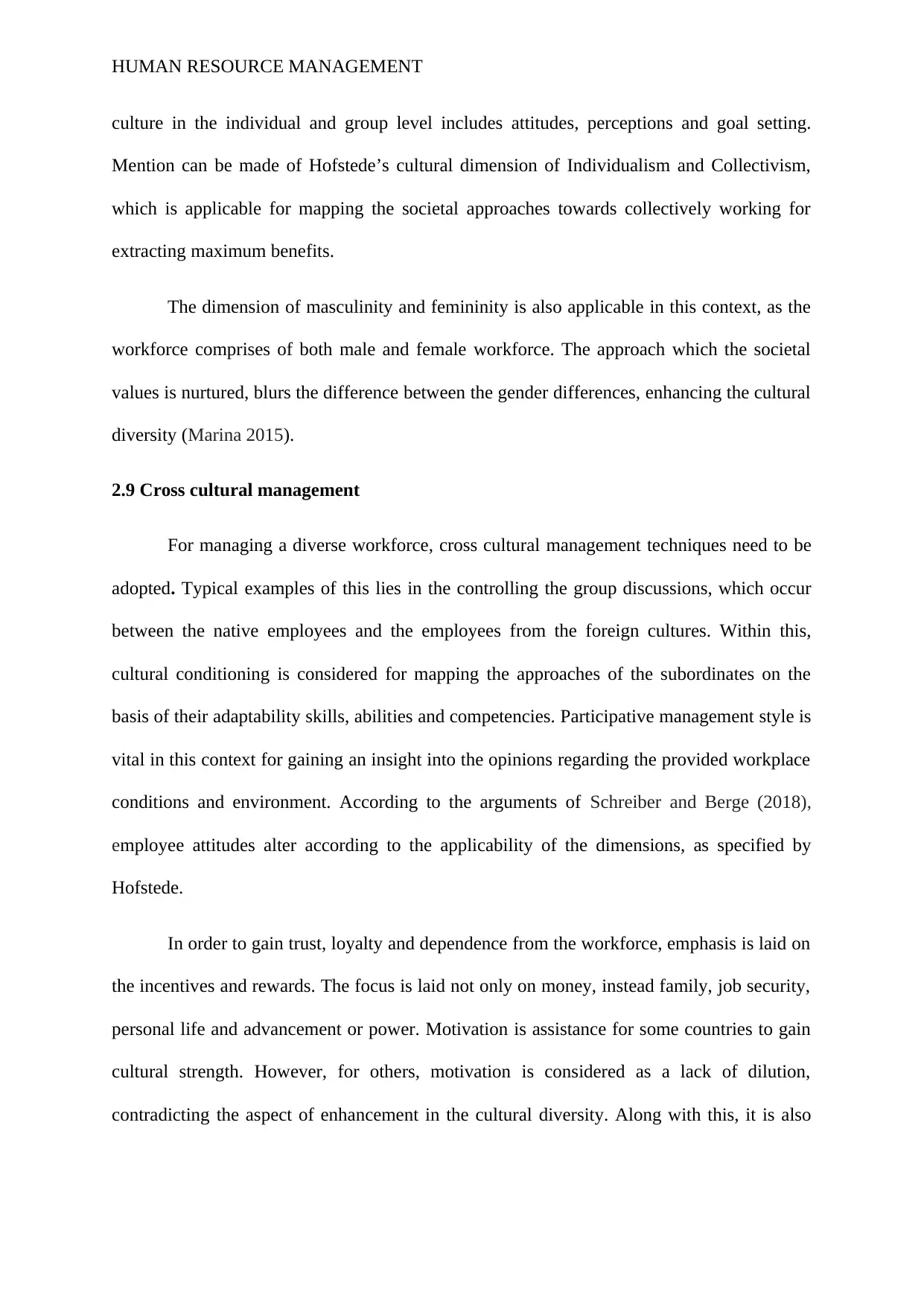
HUMAN RESOURCE MANAGEMENT
culture in the individual and group level includes attitudes, perceptions and goal setting.
Mention can be made of Hofstede’s cultural dimension of Individualism and Collectivism,
which is applicable for mapping the societal approaches towards collectively working for
extracting maximum benefits.
The dimension of masculinity and femininity is also applicable in this context, as the
workforce comprises of both male and female workforce. The approach which the societal
values is nurtured, blurs the difference between the gender differences, enhancing the cultural
diversity (Marina 2015).
2.9 Cross cultural management
For managing a diverse workforce, cross cultural management techniques need to be
adopted. Typical examples of this lies in the controlling the group discussions, which occur
between the native employees and the employees from the foreign cultures. Within this,
cultural conditioning is considered for mapping the approaches of the subordinates on the
basis of their adaptability skills, abilities and competencies. Participative management style is
vital in this context for gaining an insight into the opinions regarding the provided workplace
conditions and environment. According to the arguments of Schreiber and Berge (2018),
employee attitudes alter according to the applicability of the dimensions, as specified by
Hofstede.
In order to gain trust, loyalty and dependence from the workforce, emphasis is laid on
the incentives and rewards. The focus is laid not only on money, instead family, job security,
personal life and advancement or power. Motivation is assistance for some countries to gain
cultural strength. However, for others, motivation is considered as a lack of dilution,
contradicting the aspect of enhancement in the cultural diversity. Along with this, it is also
culture in the individual and group level includes attitudes, perceptions and goal setting.
Mention can be made of Hofstede’s cultural dimension of Individualism and Collectivism,
which is applicable for mapping the societal approaches towards collectively working for
extracting maximum benefits.
The dimension of masculinity and femininity is also applicable in this context, as the
workforce comprises of both male and female workforce. The approach which the societal
values is nurtured, blurs the difference between the gender differences, enhancing the cultural
diversity (Marina 2015).
2.9 Cross cultural management
For managing a diverse workforce, cross cultural management techniques need to be
adopted. Typical examples of this lies in the controlling the group discussions, which occur
between the native employees and the employees from the foreign cultures. Within this,
cultural conditioning is considered for mapping the approaches of the subordinates on the
basis of their adaptability skills, abilities and competencies. Participative management style is
vital in this context for gaining an insight into the opinions regarding the provided workplace
conditions and environment. According to the arguments of Schreiber and Berge (2018),
employee attitudes alter according to the applicability of the dimensions, as specified by
Hofstede.
In order to gain trust, loyalty and dependence from the workforce, emphasis is laid on
the incentives and rewards. The focus is laid not only on money, instead family, job security,
personal life and advancement or power. Motivation is assistance for some countries to gain
cultural strength. However, for others, motivation is considered as a lack of dilution,
contradicting the aspect of enhancement in the cultural diversity. Along with this, it is also
Paraphrase This Document
Need a fresh take? Get an instant paraphrase of this document with our AI Paraphraser

HUMAN RESOURCE MANAGEMENT
problematic for aligning the appropriate level of industrialization in order to extract the
maximum benefits.
Cross cultural considerations include training and development programs,
performance appraisals and remunerations (Vance and Paik 2015). Providing training to the
diversified workforce is apt for enhancing their thinking skills and judgmental capabilities.
This approach is fruitful for undertaking decisions, which are free from biasness and ethical
dilemmas. Mention can be made of the performance appraisals, which can result in the
interaction between the manager from the Western culture and the employee from other
cultures. Courteous approach in the conversations averts the instances of misunderstanding
and misinterpretation.
2.10 Theories of People management
Michigan Model of HRM can be cited for the effective management of the people,
which is the human resources. According to this model, the main focus is on rational,
quantitative and strategic aspects of human resources. In this, the hard approach is used,
which reflects the low trust management among the employees. As per the arguments of
Furnham and MacRae (2017), employees need to be managed like the management of the
other resources. Judicious usage of the resources is apt for averting the instances of
exploitation. Mention can also be made of the Harvard model of HRM, which reflects the
soft side. Superior know-how, job satisfaction, adaptability and motivation shapes the
argument for achieving competitive advantage. Diversification in this context adds value to
the decision making process for the enhancing the cultural diversity.
Resource based view is one of the other components in the theoretical considerations
for people management. Proper implementation of the policies and practices develop positive
problematic for aligning the appropriate level of industrialization in order to extract the
maximum benefits.
Cross cultural considerations include training and development programs,
performance appraisals and remunerations (Vance and Paik 2015). Providing training to the
diversified workforce is apt for enhancing their thinking skills and judgmental capabilities.
This approach is fruitful for undertaking decisions, which are free from biasness and ethical
dilemmas. Mention can be made of the performance appraisals, which can result in the
interaction between the manager from the Western culture and the employee from other
cultures. Courteous approach in the conversations averts the instances of misunderstanding
and misinterpretation.
2.10 Theories of People management
Michigan Model of HRM can be cited for the effective management of the people,
which is the human resources. According to this model, the main focus is on rational,
quantitative and strategic aspects of human resources. In this, the hard approach is used,
which reflects the low trust management among the employees. As per the arguments of
Furnham and MacRae (2017), employees need to be managed like the management of the
other resources. Judicious usage of the resources is apt for averting the instances of
exploitation. Mention can also be made of the Harvard model of HRM, which reflects the
soft side. Superior know-how, job satisfaction, adaptability and motivation shapes the
argument for achieving competitive advantage. Diversification in this context adds value to
the decision making process for the enhancing the cultural diversity.
Resource based view is one of the other components in the theoretical considerations
for people management. Proper implementation of the policies and practices develop positive
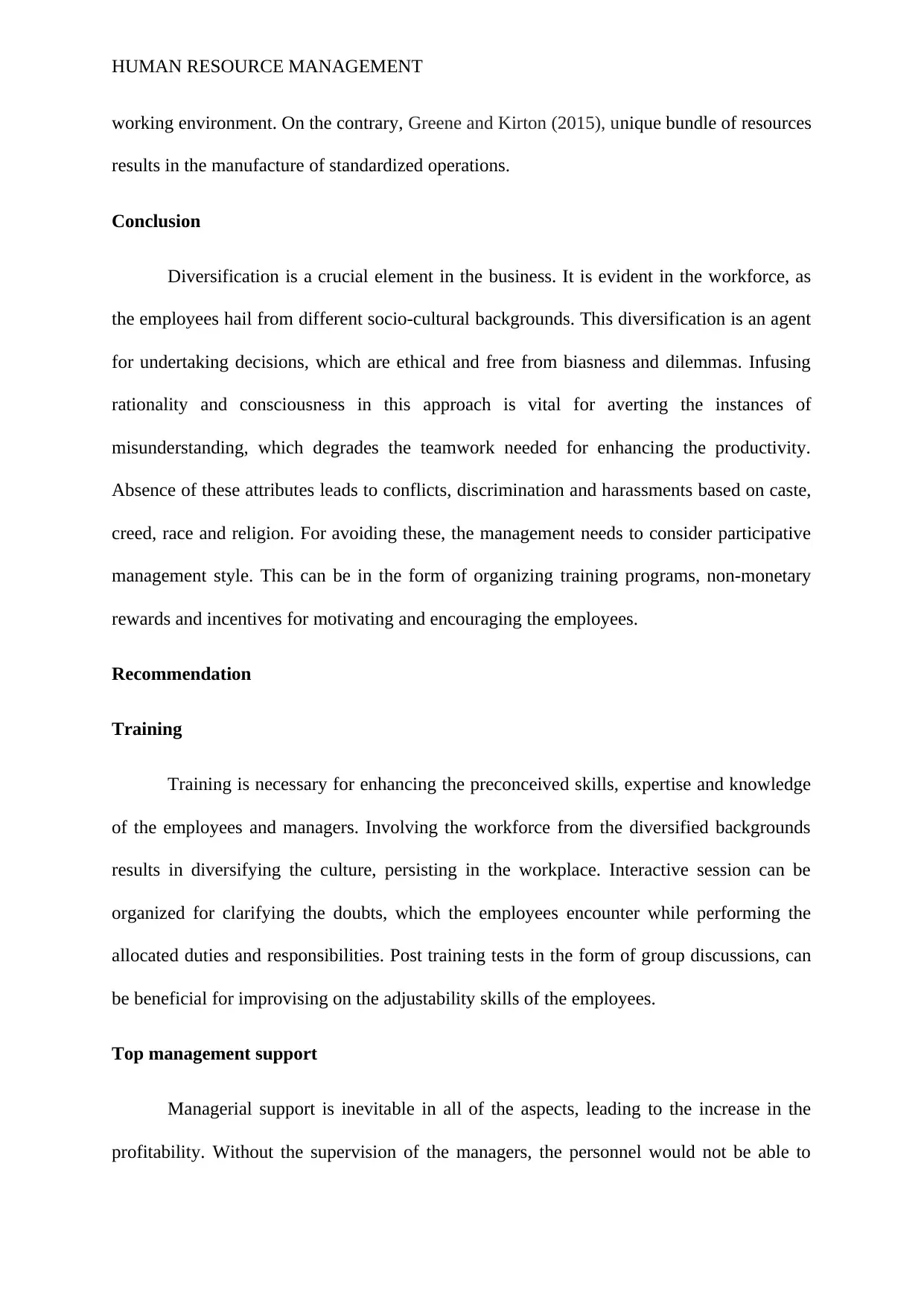
HUMAN RESOURCE MANAGEMENT
working environment. On the contrary, Greene and Kirton (2015), unique bundle of resources
results in the manufacture of standardized operations.
Conclusion
Diversification is a crucial element in the business. It is evident in the workforce, as
the employees hail from different socio-cultural backgrounds. This diversification is an agent
for undertaking decisions, which are ethical and free from biasness and dilemmas. Infusing
rationality and consciousness in this approach is vital for averting the instances of
misunderstanding, which degrades the teamwork needed for enhancing the productivity.
Absence of these attributes leads to conflicts, discrimination and harassments based on caste,
creed, race and religion. For avoiding these, the management needs to consider participative
management style. This can be in the form of organizing training programs, non-monetary
rewards and incentives for motivating and encouraging the employees.
Recommendation
Training
Training is necessary for enhancing the preconceived skills, expertise and knowledge
of the employees and managers. Involving the workforce from the diversified backgrounds
results in diversifying the culture, persisting in the workplace. Interactive session can be
organized for clarifying the doubts, which the employees encounter while performing the
allocated duties and responsibilities. Post training tests in the form of group discussions, can
be beneficial for improvising on the adjustability skills of the employees.
Top management support
Managerial support is inevitable in all of the aspects, leading to the increase in the
profitability. Without the supervision of the managers, the personnel would not be able to
working environment. On the contrary, Greene and Kirton (2015), unique bundle of resources
results in the manufacture of standardized operations.
Conclusion
Diversification is a crucial element in the business. It is evident in the workforce, as
the employees hail from different socio-cultural backgrounds. This diversification is an agent
for undertaking decisions, which are ethical and free from biasness and dilemmas. Infusing
rationality and consciousness in this approach is vital for averting the instances of
misunderstanding, which degrades the teamwork needed for enhancing the productivity.
Absence of these attributes leads to conflicts, discrimination and harassments based on caste,
creed, race and religion. For avoiding these, the management needs to consider participative
management style. This can be in the form of organizing training programs, non-monetary
rewards and incentives for motivating and encouraging the employees.
Recommendation
Training
Training is necessary for enhancing the preconceived skills, expertise and knowledge
of the employees and managers. Involving the workforce from the diversified backgrounds
results in diversifying the culture, persisting in the workplace. Interactive session can be
organized for clarifying the doubts, which the employees encounter while performing the
allocated duties and responsibilities. Post training tests in the form of group discussions, can
be beneficial for improvising on the adjustability skills of the employees.
Top management support
Managerial support is inevitable in all of the aspects, leading to the increase in the
profitability. Without the supervision of the managers, the personnel would not be able to
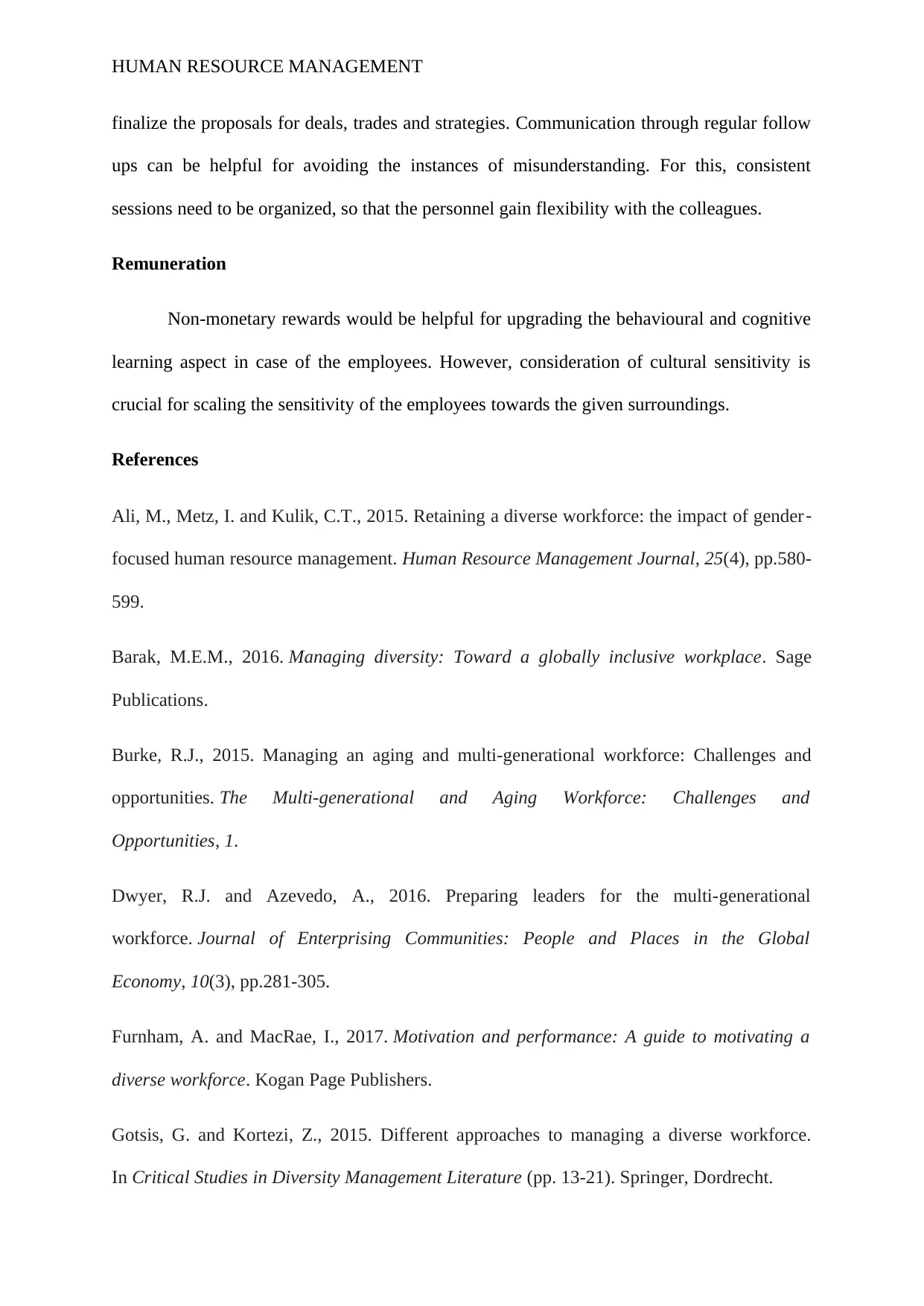
HUMAN RESOURCE MANAGEMENT
finalize the proposals for deals, trades and strategies. Communication through regular follow
ups can be helpful for avoiding the instances of misunderstanding. For this, consistent
sessions need to be organized, so that the personnel gain flexibility with the colleagues.
Remuneration
Non-monetary rewards would be helpful for upgrading the behavioural and cognitive
learning aspect in case of the employees. However, consideration of cultural sensitivity is
crucial for scaling the sensitivity of the employees towards the given surroundings.
References
Ali, M., Metz, I. and Kulik, C.T., 2015. Retaining a diverse workforce: the impact of gender‐
focused human resource management. Human Resource Management Journal, 25(4), pp.580-
599.
Barak, M.E.M., 2016. Managing diversity: Toward a globally inclusive workplace. Sage
Publications.
Burke, R.J., 2015. Managing an aging and multi-generational workforce: Challenges and
opportunities. The Multi-generational and Aging Workforce: Challenges and
Opportunities, 1.
Dwyer, R.J. and Azevedo, A., 2016. Preparing leaders for the multi-generational
workforce. Journal of Enterprising Communities: People and Places in the Global
Economy, 10(3), pp.281-305.
Furnham, A. and MacRae, I., 2017. Motivation and performance: A guide to motivating a
diverse workforce. Kogan Page Publishers.
Gotsis, G. and Kortezi, Z., 2015. Different approaches to managing a diverse workforce.
In Critical Studies in Diversity Management Literature (pp. 13-21). Springer, Dordrecht.
finalize the proposals for deals, trades and strategies. Communication through regular follow
ups can be helpful for avoiding the instances of misunderstanding. For this, consistent
sessions need to be organized, so that the personnel gain flexibility with the colleagues.
Remuneration
Non-monetary rewards would be helpful for upgrading the behavioural and cognitive
learning aspect in case of the employees. However, consideration of cultural sensitivity is
crucial for scaling the sensitivity of the employees towards the given surroundings.
References
Ali, M., Metz, I. and Kulik, C.T., 2015. Retaining a diverse workforce: the impact of gender‐
focused human resource management. Human Resource Management Journal, 25(4), pp.580-
599.
Barak, M.E.M., 2016. Managing diversity: Toward a globally inclusive workplace. Sage
Publications.
Burke, R.J., 2015. Managing an aging and multi-generational workforce: Challenges and
opportunities. The Multi-generational and Aging Workforce: Challenges and
Opportunities, 1.
Dwyer, R.J. and Azevedo, A., 2016. Preparing leaders for the multi-generational
workforce. Journal of Enterprising Communities: People and Places in the Global
Economy, 10(3), pp.281-305.
Furnham, A. and MacRae, I., 2017. Motivation and performance: A guide to motivating a
diverse workforce. Kogan Page Publishers.
Gotsis, G. and Kortezi, Z., 2015. Different approaches to managing a diverse workforce.
In Critical Studies in Diversity Management Literature (pp. 13-21). Springer, Dordrecht.
Secure Best Marks with AI Grader
Need help grading? Try our AI Grader for instant feedback on your assignments.
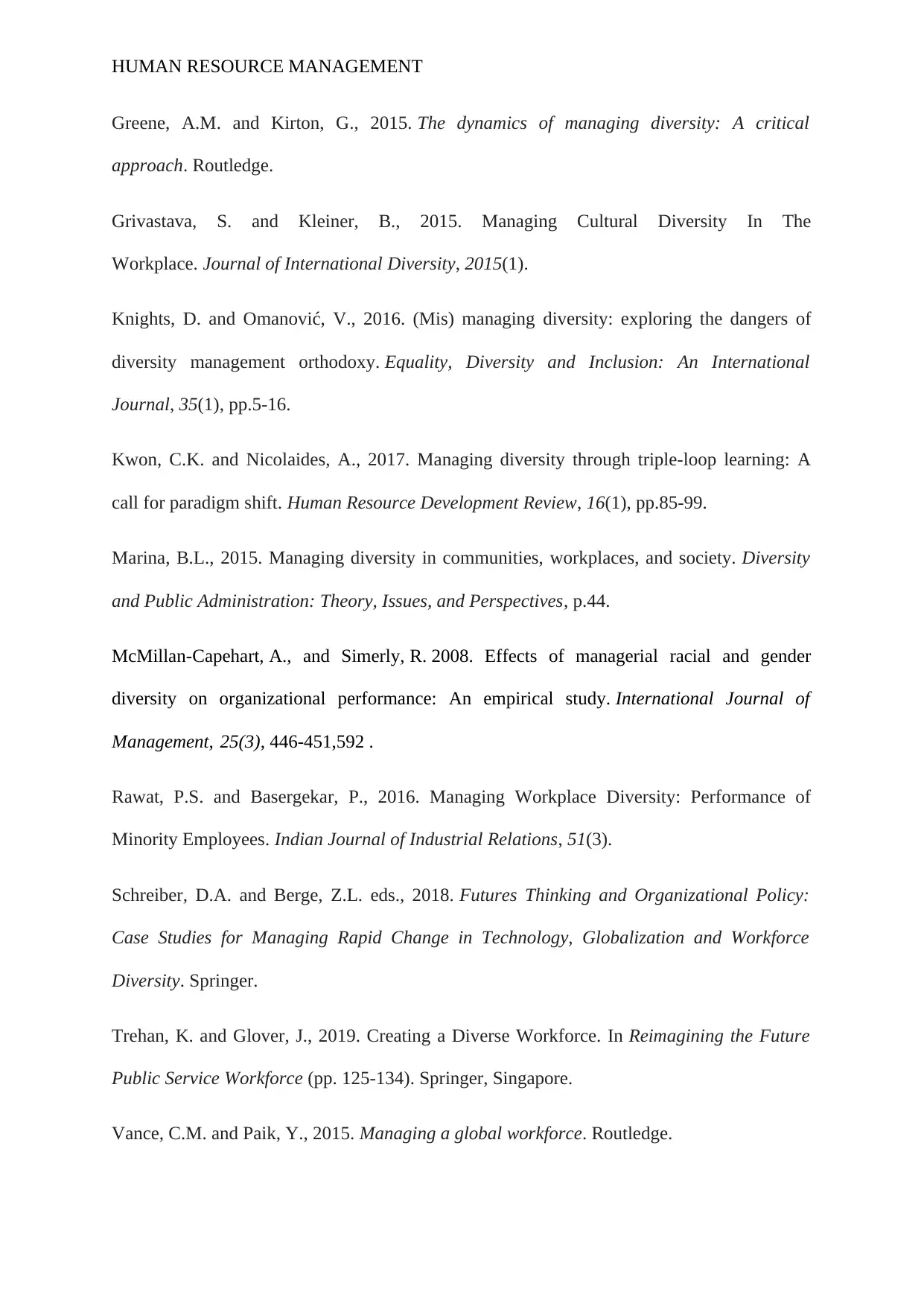
HUMAN RESOURCE MANAGEMENT
Greene, A.M. and Kirton, G., 2015. The dynamics of managing diversity: A critical
approach. Routledge.
Grivastava, S. and Kleiner, B., 2015. Managing Cultural Diversity In The
Workplace. Journal of International Diversity, 2015(1).
Knights, D. and Omanović, V., 2016. (Mis) managing diversity: exploring the dangers of
diversity management orthodoxy. Equality, Diversity and Inclusion: An International
Journal, 35(1), pp.5-16.
Kwon, C.K. and Nicolaides, A., 2017. Managing diversity through triple-loop learning: A
call for paradigm shift. Human Resource Development Review, 16(1), pp.85-99.
Marina, B.L., 2015. Managing diversity in communities, workplaces, and society. Diversity
and Public Administration: Theory, Issues, and Perspectives, p.44.
McMillan-Capehart, A., and Simerly, R. 2008. Effects of managerial racial and gender
diversity on organizational performance: An empirical study. International Journal of
Management, 25(3), 446-451,592 .
Rawat, P.S. and Basergekar, P., 2016. Managing Workplace Diversity: Performance of
Minority Employees. Indian Journal of Industrial Relations, 51(3).
Schreiber, D.A. and Berge, Z.L. eds., 2018. Futures Thinking and Organizational Policy:
Case Studies for Managing Rapid Change in Technology, Globalization and Workforce
Diversity. Springer.
Trehan, K. and Glover, J., 2019. Creating a Diverse Workforce. In Reimagining the Future
Public Service Workforce (pp. 125-134). Springer, Singapore.
Vance, C.M. and Paik, Y., 2015. Managing a global workforce. Routledge.
Greene, A.M. and Kirton, G., 2015. The dynamics of managing diversity: A critical
approach. Routledge.
Grivastava, S. and Kleiner, B., 2015. Managing Cultural Diversity In The
Workplace. Journal of International Diversity, 2015(1).
Knights, D. and Omanović, V., 2016. (Mis) managing diversity: exploring the dangers of
diversity management orthodoxy. Equality, Diversity and Inclusion: An International
Journal, 35(1), pp.5-16.
Kwon, C.K. and Nicolaides, A., 2017. Managing diversity through triple-loop learning: A
call for paradigm shift. Human Resource Development Review, 16(1), pp.85-99.
Marina, B.L., 2015. Managing diversity in communities, workplaces, and society. Diversity
and Public Administration: Theory, Issues, and Perspectives, p.44.
McMillan-Capehart, A., and Simerly, R. 2008. Effects of managerial racial and gender
diversity on organizational performance: An empirical study. International Journal of
Management, 25(3), 446-451,592 .
Rawat, P.S. and Basergekar, P., 2016. Managing Workplace Diversity: Performance of
Minority Employees. Indian Journal of Industrial Relations, 51(3).
Schreiber, D.A. and Berge, Z.L. eds., 2018. Futures Thinking and Organizational Policy:
Case Studies for Managing Rapid Change in Technology, Globalization and Workforce
Diversity. Springer.
Trehan, K. and Glover, J., 2019. Creating a Diverse Workforce. In Reimagining the Future
Public Service Workforce (pp. 125-134). Springer, Singapore.
Vance, C.M. and Paik, Y., 2015. Managing a global workforce. Routledge.
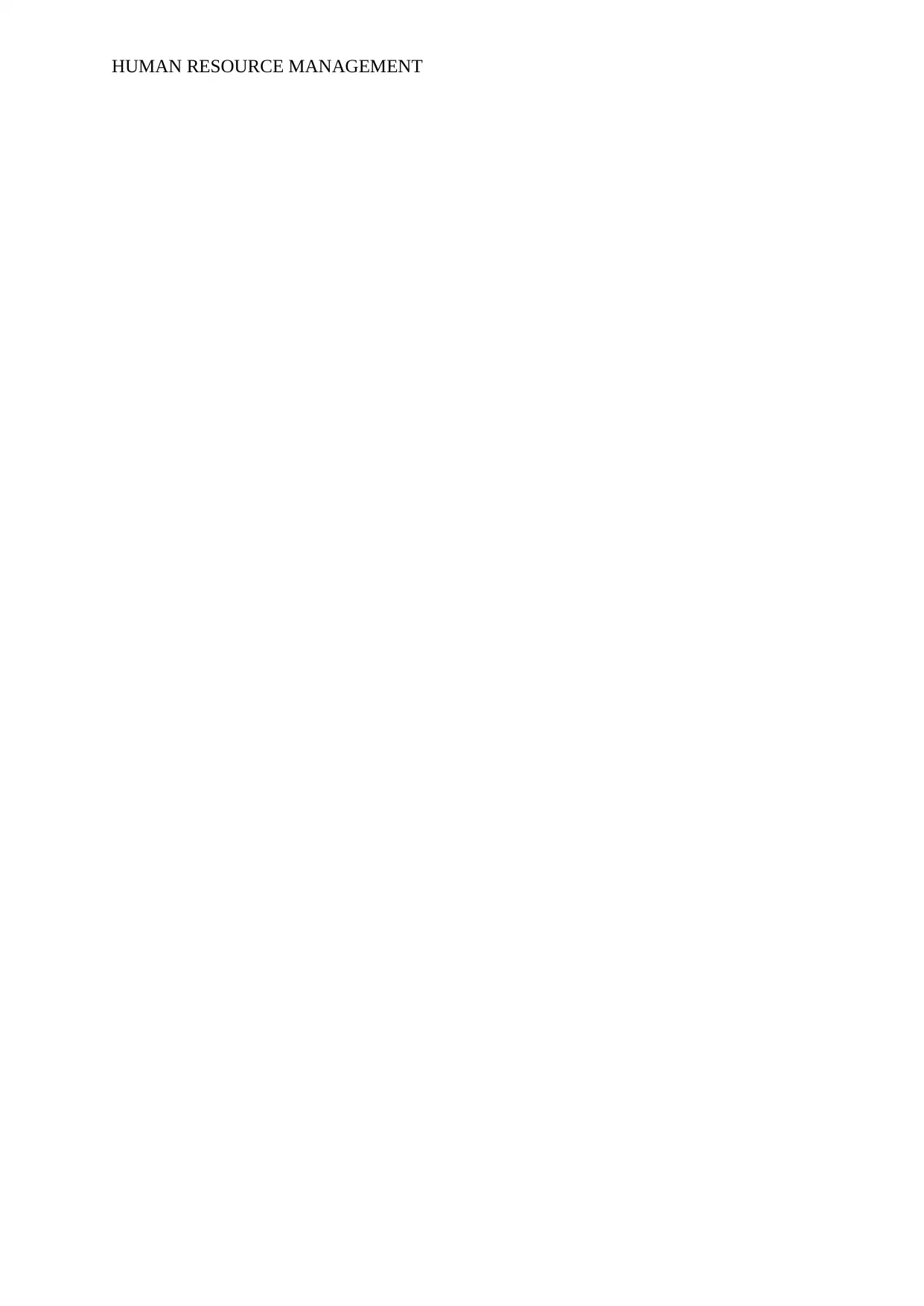
HUMAN RESOURCE MANAGEMENT
1 out of 12
Related Documents
Your All-in-One AI-Powered Toolkit for Academic Success.
+13062052269
info@desklib.com
Available 24*7 on WhatsApp / Email
![[object Object]](/_next/static/media/star-bottom.7253800d.svg)
Unlock your academic potential
© 2024 | Zucol Services PVT LTD | All rights reserved.





